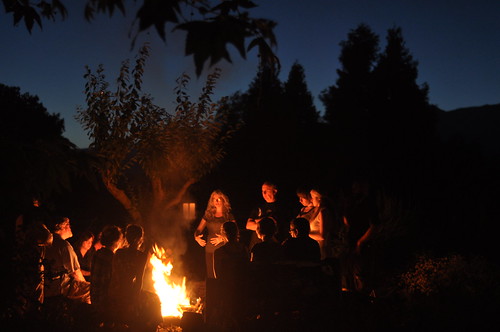Latest Posts
 Crossposted from As of Yet Untitled.
Crossposted from As of Yet Untitled.
Two weeks ago, Newsweek published a calculatedly inflammatory cover story in response to the “Innocence of the Muslim” protests in the Middle East. The cover featured a photo of protesters faces contorted in anger with the caption “Muslim Rage”. Newsweek also started an accompanying Twitter hashtag: #Muslimrage. Newsweek was fueling the flames that we already there: U.S. righteous disdain and disgust for the anger of Muslim protesters in response to a Youtube video.
For those of in the United States, I think this is a Matthew 7:5 moment. It’s comforting to settle into our moral high horse as we look at the killings in Libya of the U.S. ambassador. Certainly these deaths are tragic and wrong. But let’s consider what the plank in our own eye might be in this situation.
(more…)
TimN
October 1, 2012
International Relations, Peace & Peacemaking, US Military, war
Read more >
When God tells us to love everybody, even those who don’t love us back (Matt. 5:44/Luke 6:27-28), isn’t this an imitation of the way God loves?
When God tells us to be generous and give to everyone (Matt. 5:42/Luke 6:30), isn’t this a reflection of God’s universal generosity?
When God tells us to be merciful and compassionate (Matt. 5:48/Luke 6:36), aren’t we following the example of God’s compassion and mercy?
When God tells us to be nonviolent in the face of violence (Matt. 5:39-40/Luke 6:29), isn’t it because God is the ultimate pacifist? (more…)
CharlieK
September 18, 2012
Evangelism, Tolerance
Read more >
Cross-posted from As of Yet Untitled
It’s been less than 24 hours sine the tragic shooting this Sunday in Wisconsin. We grieve for all the victims, their family and their communities. The LA Times is reporting that the gunman had tattoos and biographical details which lead officials to conclude he had a “political agenda”. While we don’t know for sure what that political agenda is, the attack does fit a pattern that in which Sikhs have been mistaken for Muslims in attacks by Islamophobic extremists since the 9/11 attacks.
This is another opportunity for Christians in the US to reflect on our response to the ugly Islamophobia that bubbles just beneath the surface and spills out in attacks against all people that appear Middle Eastern.
There would plenty of examples I could cite, but the prominent Christian leader Franklin Graham exemplifies this anti-Muslim trend. From 2002 through 2011, Graham has consistently made comments that stoke fear and paranoia towards Muslims in the US, saying that Islam “preaches violence” (2002) and is “evil” (2009). Last year he offered this:
“The Muslim Brotherhood is very strong and active in our country. It’s infiltrated every level of our government. Right now we have many of these people that are advising the US military and State Department on how to respond in the Middle East, and it’s like asking a fox, like a farmer asking a fox, “How do I protect my henhouse from foxes?” We’ve brought in Muslims to tell us how to make policy toward Muslim countries. And many of these people we’ve brought in, I’m afraid, are under the Muslim Brotherhood.”
(all quotes from Franklin Graham and Samaritan’s Purse, Sheila Musaji)
(more…)
TimN
August 6, 2012
Interfaith, Islam, The Bible
Read more >
It’s been a month since Charletta and I arrived in the Los Angeles airport direct from our time with Christian Peacemaker Teams in Colombia. Now that we’ve caught our breath, I wanted to share with you a window into our first two whirlwind weeks here in the Ojai valley working with Bartimaeus Cooperative Ministries. Charletta and I were part of preparing for and hosting the July Bartimaeus Institute entitled “Rooting Faith: Theology and Practices of Bioregional Discipleship.” I focused on documenting the week for a wider audience through photography and video. This is my first experiment in Youtube journalism. Rather than write a lot about the week, I’ll give a basic introduction and then share the videos that I created:

On the first night of the institute we gathered around the fire to sing songs and talk together at dusk (above). Aside from lodging, the event was hosted by Ched Myers and Elaine Enns in their house and their yard, which is entirely given over to vegetables, fruit trees and native plants. Mornings were spent doing Bible study and studying permaculture and afternoons were spent doing hands on learning of permaculture techniques in the garden. Evenings were practical workshops on a variety of subjects. Chris Grataski and Melissa Shank taught us about permaculture and herbalism.
(more…)
TimN
July 30, 2012
bioregionalism, Civilization, Discipleship, Permaculture, The Bible
Read more >
Cross-posted from As of Yet Untitled (with different introduction)

Over the years here on YAR, discussions about the differences between the approach of the (Old) Mennonite Conference (MC) and General Conference (GC) have cropped up now and again. This comment from AlanS from 2010 is probably one of the most insightful. For non-Mennonites or those who have joined in the last 12 years, these reference are mysterious. Nevertheless, for those of of us working for change in the Mennonite church, understanding these differences are critical. To that end, here is my interview with Lin Garber, the convener of Mennoneighbors and a writer and editor. Lin graduated from Goshen College in 1957 and is a member of The Mennonite Congregation of Boston.
Tim: Lin, in a comment on The Mennonite website* you discussed the differering approaches of General Conference (GC) and the “Old” Mennonite Church (MC) to Section III (“Clarification on some issues related to homosexuality and membership”) of Membership Guidelines for the formation of Mennonite Church USA (2001). For those who have never heard of the terms GC and MC, can you briefly explain some of the history?
Lin: Today’s Mennonite Church Canada (MC Canada) and Mennonite Church USA (MC USA) took their present forms around 2000 in what was termed a “transformation” (as opposed to discarded language like merger and integration). What had been the Mennonite Church, often informally and unofficially referred to as the “Old” Mennonites (MC), stemmed largely from 18th-century immigrants to North America with Swiss and south German origins. It had conferences in both the United States and Canada, a few of which had congregations on both sides of the border, but the bulk of its membership was in the United States.
What had been the General Conference Mennonite Church came out of a movement within the “Old” Mennonites of southeastern Pennsylvania in 1847 that in 1860 organized as the General Conference of the Mennonite Church of North America. A main stated goal of the group was to unite all Mennonites into one body. It grew slowly over the next dozen years as a few congregations decided to join it, but starting in 1874 its membership exploded with the influx of immigrants from central Europe and especially from southern Russia, mostly the Ukraine. The bulk of these immigrants were of Dutch-Prussian (i.e., north German) descent, and those cultural influences came to dominate. At the time of the “transformation” around 2000, the membership of the GC was roughly balanced between the United States and Canada, with the United States having a slight edge.
(more…)
TimN
July 26, 2012
LGBTQ, Mennonite Church USA, Power
Read more >
“Pink Smoke Over the Vatican” tells the story of the struggle for women to be ordained in the Roman Catholic Church. Through interviews and historical vignettes, it portrays the tragedy of deeply gifted women, called by the spirit, but rejected by their own leaders.
In watching the movie, it was tempting at times to distance myself from the Roman Catholic Church. After all, I’m Anabaptist, and we don’t believe in the church hierarchy or that priests are a necessary bridge to reach God. But I realized that the story of the men in this documentary is my story as a Christian man.
The most moving scene in the film is the ordination of women as priests by a woman bishop. The scene brought unexpected tears to my eyes. My mother experienced deep pain from the Mennonite church where I grew up. Her call to leadership as Sunday school superintendent led to some members leaving the church, and she felt abandoned by male leaders. The story of these women joyfully entering the priesthood is my mother’s story and it is my story.
(more…)
TimN
July 15, 2012
activism, Roman Catholic, Sexism
Read more >
Reading old Newspapers can often be an exciting experience. Especially in small town newspapers many editors were quite blunt and do the point. Sometimes this makes for rather humorous descriptions of the rough and tumble life of early white frontier settlers. Other times, their bluntness cut straight to the heart of an issue, convicting not only the readers of old but those who still gaze upon the articles today. Recently I found such an article.
On May 18, 1888 the Harper Daily Sentinel in Harper, Ks published an op-ed piece about one of the Asian workmen who had left Harper to go back home. While the wording grates on modern sensibilities, especially in the final sentence, the point comes across loud and clear.
 (more…)
(more…)
AlanS
July 12, 2012
Evangelism, Global Church, Mennonite Church USA
Read more >
We are Mennonites (and fellow travelers) who reject the church’s mission activities.
We believe Christian mission, historically, goes hand-in-hand with cultural destruction. We love human diversity and seek to preserve it. Thus, we oppose evangelistic crusades and mission boards that proselytize, no matter how well-meaning they claim to be.
We reject the authenticity of the so-called “Great Commission” (Matt. 28:19-20). We simply don’t think Jesus said it. Most New Testament scholars doubt its authenticity as well, for a couple reasons. Firstly, any statements supposedly made by Jesus after his death must be called into question. Secondly, if Jesus told his followers to go out and convert the world, then the debate about the inclusion of Gentiles during Paul’s time makes little sense. To modern scholars, the “Great Commission” sounds more like the post-70-A.D. church talking than the historical Jesus.
(more…)
CharlieK
July 7, 2012
Bigotry, Evangelism, Exclusion, Hate, Indigenous, Interfaith, Interpretation, Tolerance
Read more >
As the sun hovered at the horizon, I got into the big canoe with 20 people from Las Pavas. We were mostly men with a few woman and one young boy. We pulled away from the bank of the river and began motoring towards the sunset, racing against the light.

(more…)
TimN
June 25, 2012
Corporations, Peace & Peacemaking, Politics, Power
Read more >
Since we’ve been covering Anabaptist Mission Project events here on YAR, here is info about upcoming event:
The Spirit’s Work in Mission: Prophesying about many peoples, July 30-July 1
Anabaptist Missional Project, a group of young leaders in the Mennonite Church, hosts its second annual gathering June 30-July 1, at Oxford Circle Mennonite Church, Philadelphia, PA. Leonard Dow, Madeline Maldonado and David Maldonado will lead conversations that focus on the Spirit’s work in the growing diversity of MCUSA. Proclaiming the gospel of Jesus Christ brings diversity. Now what will we do? More details and registration are here.
See YAR coverage of their first annual gathering last year.
admin
June 23, 2012
Anabaptism, Young Folks
Read more >
Love, compassion, joy, and equanimity are some of the hallmarks of the teachings of Jesus. But those concepts didn’t originate with Jesus.
He found them tucked away in the nooks and crannies of the Torah. Almost every saying in the Sermon on the Mount is a commentary on passages from the Hebrew Scriptures. The genius of Jesus was the way in which he put his own “spin” on the Scriptures, highlighting and elevating the positive aspects of God’s personality, while ignoring and rejecting the negative aspects.
The ideals of love, compassion, joy, and equanimity weren’t the unique property of the Judaic tradition, however. They could also be found earlier, and further east, in what is now India, Nepal, Bhutan. In the Fifth Century before Jesus, a man named Gotoma developed a body of teachings based on what are called “The Four Immeasurables”: (more…)
CharlieK
June 18, 2012
Anabaptism, Awesome Stuff, Change, Church, City, Civilization, communication, Community, Contemplation, culture, Current Events, Dumb Stuff., Education, End Times, Ethics, Evangelism, extinction, Foreign Policy, Global Church, God, Group Identity, History, Indigenous, Interfaith, International Relations, Judaism, Love, MCC, Mennonite Church USA, Nonviolence, The Bible, Tolerance, Urban Ministry
Read more >
Crossposted from As of Yet Untitled
I’ve been here in Colombia with Christian Peacemaker Teams (CPT) for a week and a half. This week I’ll be visiting Las Pavas, where CPT has been working with 123 families since 2009. They have been struggling to get title to the land where they have lived for decades while A palm oil company has been trying to push them off.
My colleague and I will be a presence with Las Pavas during an official visit by INCODER, the Colombian agency who grants land titles. I’m looking forward to meeting the community personally for the first time since I’ve been hearing about them for so many years.
Here’s a brief summary of the Las Pavas story from an article last year by the Colombia team.
The people of Las Pavas are a sustainable farming community in the southern Bolivar department (province) of Colombia. Through the years, paramilitary violence has forced community members to leave the land but each time they have returned. In 2006, the community was in the process of claiming its land rights under Colombian law when a Daabon consortium bought the land from absentee owner, who had lost his rights to the land due to years of abandonment. On 14 July 2009, the Colombian riot police forcefully removed the community of Las Pavas.
(more…)
TimN
June 17, 2012
Corporations, Peace & Peacemaking, Tactics
Read more >
It’s difficult to know where to begin reporting on the #Occupy Empire mini conference that took place at Eastern Mennonite Seminary back in April. Though the conference was short, there was nothing “mini” about the content lined up by the conference planners, Brian Gumm and Aaron Kauffman. Thus what I offer here is a reflection on the themes that stood out to me. Others might have noticed different threads woven throughout the weekend, or simply have been alert and listening carefully during those moments when I distracted by refilling my coffee mug. I won’t pretend to hit on every single presenter and every important theme that was brought up. This is simply what challenged me, and I’m grateful to have had the opportunity to attend the conference.
(more…)
MeghanF
June 1, 2012
Anabaptism, Poweranabaptists, empire, mission, occupy, Power
Read more >
On the great day of judgment, all of humanity was gathered in a celestial banquet hall. It was a huge space, with a massive round table in the middle. The table was so big that it accommodated what seemed to be hundreds of thousands of people, probably more. As one looked to the left or the right, there were people as far as the eye could see. Yet somehow, by some supernatural optical phenomenon, one had no trouble seeing clearly everyone seated directly across the table. In a position of prominence was the Almighty herself, who interestingly had an appearance not unlike the way God was portrayed in Monty Python’s “Life of Brian,” yet whose Voice was unmistakably feminine. After a while, some grumbling was to be heard, as people began to take notice of who was present. Finally, a lone voice cried out, a voice with a thick Brooklyn accent, saying, “Hey God, I’m happy to be here, of course, but I see my old neighbor Moshe sitting over there and I know that rotten sonofabitch rascal ought to be in the other place. What gives?” (more…)
CharlieK
May 20, 2012
Anabaptism, Awesome Stuff, City, Community, Dumb Stuff., End Times, Evangelism, God, Group Identity, Interfaith, Love, Mennonite Church USA, Sex, Tolerance
Read more >
During this particular moment of time, as large numbers of younger Evangelicals are leaving the church for nominalism or into the camp of the 16% of the US which make up the spiritually “unaffliated”, I believe that the Anabaptist Tradition has massive resources to offer the North American Body of Christ at large, especially the conservative Evangelical tradition of my upbringing.
I am utterly compelled that the thought and praxis of the Radical Reformation uniquely confronts the weaknesses of North American Evangelicalism, a tradition credited (through the almost universal marriage with the GOP) with the 8-years of unjust Bush policies (two wars, the Patriot Act, trickle-down economics, etc), as well as a virtual obsession with “biblical” issues like abortion & gay marriage (and, yes, Obama has not fared much better in his quest to set records with drones and deportations).Â
In addition, Anabaptism is well-equipped to confront narcissism, instant gratification, consumerism and celebrity worship saturating us everyday. As Nancey Murphy wrote a few years back, referring to the “distinctive” characteristics of Anabaptism (nonviolence, revolutionary subordination, the separation of church and state and learning to live with less),
“All four of these radical-reformation distinctives can be seen as strategies for living in such a way as to curb the will-to-power.” (more…)
TomA
May 4, 2012
Church
Read more >
 Crossposted from As of Yet Untitled.
Crossposted from As of Yet Untitled.



